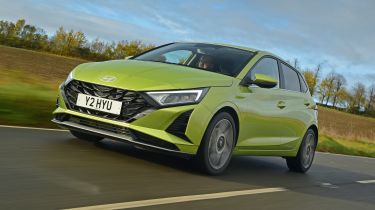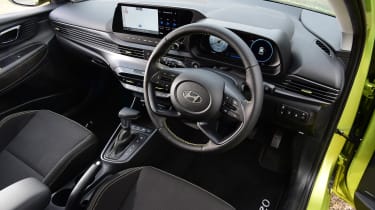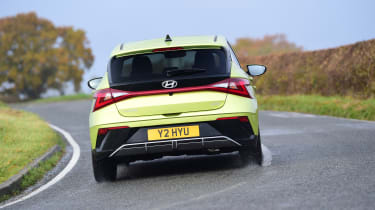New Hyundai i20 facelift 2023 review: subtle updates for an already stylish supermini
Hyundai has given the i20 a series of mid-life updates, but you might struggle to notice some of them

Verdict
The Hyundai i20 was a compelling and undeniably stylish supermini and the new facelifted version changes little other than subtle revisions to the car’s looks. Unfortunately this also means that interior quality hasn’t risen to match the best in this class, while the firm ride only pays dividends on twistier roads.
With the Ford Fiesta now six feet under, Hyundai has decided to seize the moment by giving its contender in the supermini battle royale a mid-life facelift. It’s not the only brand to do so, with key rivals like the Renault Clio, Vauxhall Corsa and Peugeot 208 having also gone under the knife in recent times, so the i20 has some tough competition on its hands.
While those other facelifted superminis each received rather dramatic styling updates – the Clio and Corsa in particular – identifying the visual changes made to the i20 makes for a tricky game of spot the difference. We won’t make you crack out the magnifying glass though; up front, there’s a new radiator grille and restyled bumper with large air intakes. The LED headlights from the previous N Line model are now standard-fit, while the traditional Hyundai badge has been moved from the grille to the base of the bonnet.
Used - available now
Hyundai has also updated the 16- and 17-inch wheel options with new designs, added a new set of distinctive Z-shaped LED tail-lights, and tweaked the rear bumper that gets a prominent faux diffuser. Meanwhile new paint options include the remarkably vivid Lucid Lime Metallic our test car came in.
Ultimately, this facelift certainly isn’t as transformative as the one the Renault Clio received earlier this year, but the i20 was already a knockout, so we’re glad Hyundai took the ‘less is more’ approach in many respects.
The i20’s interior is just as heavily styled as the exterior, although that’s not new. The ribbed dashboard design, climate controls that protrude towards the driver and funky four-spoke steering wheel are the same as before, as are the screen sizes – more on those later. The example we drove also got stitching and interior accents to match the highlighter green paint, which may be a tad too flamboyant for some, but each to their own.
Either way, it’s nice that Hyundai chose to instil the cabin with a touch of flair, which is uncommon in this class, however we wish it had spent some time improving the material quality as part of this facelift. Almost every surface is made from cheap-feeling scratchy plastics, with the few that aren’t like the dashboard or door’s armrest covered by a dismally thin layer of soft-touch material. So while the design of the Clio’s cabin is more simplistic, material quality is considerably better, which makes all the difference in the long run.
The tech onboard is the saving grace of the cabin. Every i20 is equipped with an excellent 10.25-inch digital driver’s display that’s crisp and responsive, accompanied by either an eight or 10.25-inch central touchscreen, depending on the exact specification.
Hyundai’s infotainment system continues to impress us and is easily among the best in the business. Even though the i20 doesn’t use the very latest version from the new Kona SUV, it does provide intuitive menus and slick graphics, along with the usual Apple CarPlay and Android Auto smartphone connectivity that is standard across the range. The ‘sounds of nature’ feature that allows the driver to play soundscapes of forests or busy city streets is still utterly pointless in our opinion.
The kit list also includes Hyundai’s SmartSense suite that bundles forward collision alert, driver attention alert, high beam assist, lane keep and follow assist, plus intelligent speed limit warning, among others.
Understandably, cabin space hasn’t changed, so there’s a decent amount of legroom on offer in the rear and headroom is generous, allowing the i20 to accommodate four adults without too much whinging. The 352-litre boot is also on par with the Volkswagen Polo’s and Skoda Fabia’s, and trumps the Vauxhall Corsa’s 309-litre luggage capacity.
The i20 also remains available exclusively with a turbocharged three-cylinder petrol engine, but rather oddly, Hyundai decided to remove its 48V mild-hybrid system when it updated the car. It’s not a massive loss per se, as the main benefits of the setup was extended start-stop capabilities for a very slight improvement in fuel economy and CO2 emissions compared to some pure-petrol superminis. But it still feels like a step backwards when you consider other small cars are now being fitted with full-hybrid or even electric drivetrains.
Either way, the i20’s revised setup produces a perfectly adequate 99bhp and 172Nm of torque. It’s just enough to get the basic manual model from 0-62mph in a reasonable 10.4 seconds, while models like ours equipped with the optional seven-speed dual-clutch automatic need 11.4 seconds to hit the same speed.
We found the dual-clutch i20 is smooth to drive around town, with the automatic transmission providing seamless gear changes. Visibility is good all round too, but the ride is quite firm – firmer than we’d expect from a Hyundai – and as result the i20 jiggles about and never quite manages to settle down. It's not uncomfortable though, nor does it crash into potholes.
The firm ride pays dividends when you swap the town centre for a winding B-road, as the i20 manages to stay composed when changing direction quickly. We wouldn’t say the i20 is the most rewarding small car to drive unfortunately, as despite the pleasing weight of the steering and its precise nature, it feels numb. Stomping on the accelerator also causes the gearbox to kick down hard, yet on more than one occasion it failed to pick the optimal gear, meaning we got plenty of noise before the car got its act together and we started to gain speed.
Personally, we wouldn’t bother upgrading from the standard six-speed manual to the dual-clutch automatic. Stick with swapping gears yourself and save yourself £1,200 in the process. If you fancy a more effortless driving experience, the full-hybrid Renault Clio is a breeze around town and starts from £21,295, compared to £22,020 for the most basic Hyundai i20 DCT.
| Model: | Hyundai i20 Ultimate DCT |
| Price: | £25,320 |
| Engine: | 1.0-litre 3cyl turbo |
| Transmission: | Seven-speed dual-clutch automatic, front-wheel drive |
| Power/torque: | 99bhp/172Nm |
| 0-62mph: | 11.4 seconds |
| Top speed: | 115mph |
| Economy: | 50.4mpg |
| CO2: | 127g/km |
| On sale: | Now |
| L/W/H: | 4,065/1,775/1,450mm |














